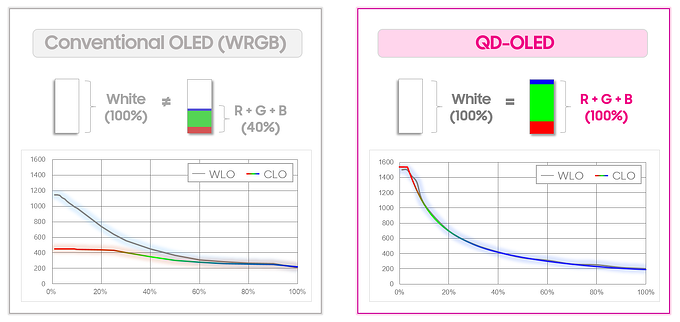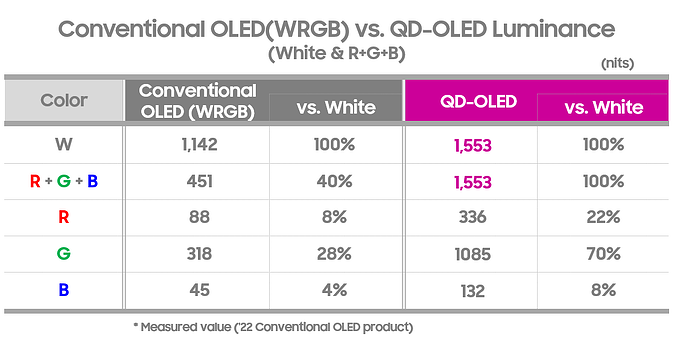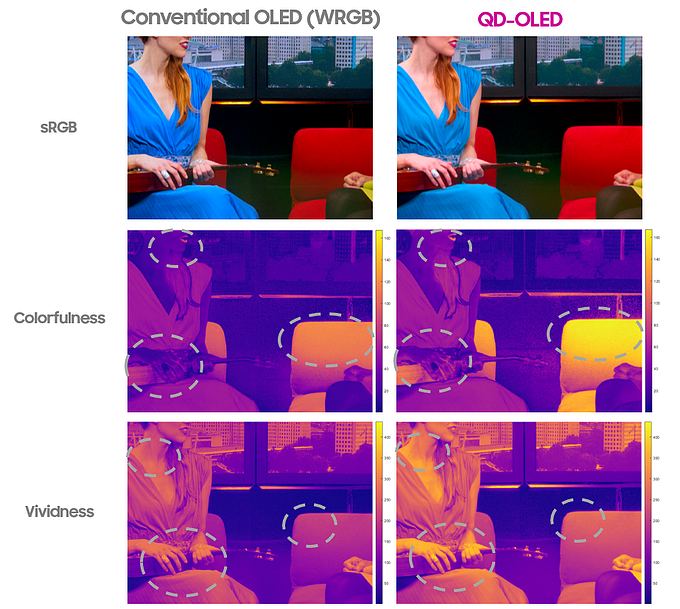How the QD-OLED True RGB pixel Improves TV and Monitor Picture Quality
QD-OLED elevates your viewing experience with bright and vivid colors when compared to OLED(WRGB).
As HDR content increases consumer adoption in movies and games, more HDR-capable Display products are being introduced to meet this demand. What makes this HDR content so immersive? It is a combination of specular details (luminance), Inky Blacks and Color brightness (color volume) like never before. While peak luminance is often singled out, without the other two it paints a partial performance picture. Some self-luminous displays add white light (e.g. Conventional OLED RGB+W pixel) to achieve higher peak brightness. This will allow them to claim higher “white” luminance, but it will not achieve high-color peak luminance. And since almost all the content you see is in color, one can easily deduce that color brightness (a.k.a. color light output) is more important.
The color-sensing part of the human eye consists of a trichromatic receptor with three cone cells that respond to specific spectral sensitivities. Similarly, the most efficient way to produce color in a display is to use a combination of red, green, and blue light (the three primary colors). This is called additive color mixture, and additive color mixing creates each new color in the process of adding colors together. The different combinations of wavelengths work well together to create the incredible variety of colors you see when looking at the display.

[Figure 1.] Luminance (*WLO & *CLO), Conventional OLED (WRGB) vs. QD-OLED
(*WLO : white light output = Peak white luminosity, *CLO : color light output = Peak Red + Peak Blue + Peak Green)
QD-OLED implements color with a combination of three primary colors consisting of RGB sub pixels in accordance with the additive color mixing method. As a result, high white luminance can be realized without compromising overall color accuracy. Figure 1. shows the luminance values of WLO and CLO by load (=Average Picture Level) of QD (RGB sub pixel) and Conventional OLED (WRGB sub pixel). In the case of QD-OLED, the luminance of WLO and CLO is almost the same (100%), but in the case of Conventional OLED (WRGB), since it consists of WRGB sub-pixels, the CLO/WLO ratio is a fraction of the WLO. (40% @ 3% APL). (Table 1.)
The additional white boost though succeeds in increasing the white luminance it also constraints the color luminance by washing out the brighter and saturated colors. Any 4-color pixel approach that includes a white sub pixel for luminance enhancement will use a white pixel to achieve peak luminance, so it will not fit the additive color mixing method.
In 4-color pixel display, white pixel can significantly impair color accuracy when implementing color by additive color mixing method. (Figure 2.) Typically, Conventional OLED (WRGB) method is such a 4-color pixel display.

[Table 1.] Luminance (White & R+G+B), Conventional OLED (WRGB) vs. QD-OLED

[Figure 2.] Conventional OLED (WRGB) vs. QD-OLED Vividness image
Conventional OLED (WRGB) uses white pixels to increase ‘brightness’ and bright colors often look ‘less’ vivid whereas dark areas of the screen sometimes appear a bit dull. In contrast, QD-OLED is capable of displaying extremely vivid colors across the entire luminance range, resulting in superior color volume performance.
Source : Dr. K. Masaoka (NHK Japan)
This is best explained with the color volume animation created by Dr. K. Masaoka of NHK, who is one of the key people who defined the BT.2020 color standard. This image portrays the BT.2020 color volume plotted in CIELAB color coordinates. In CIELAB, a fixed distance between any two points within the solid corresponds to the same amount of perceived color change.
In QD-OLED, due to the RGB pixel, white light output (WLO) is equal to the sum of the peak red, peak green and peak blue levels. In other words, the RGB color light output equals 100% of the white light output, but Conventional OLED (WRGB) uses White + RGB pixel structure. So the color light output is less than the peak white luminance.
When the color light output (CLO) to white light output (WLO) is low, or in other words, a white boost is used to bump up the luminosity, it results in loss of reproducible colors, especially the loss of bright and vivid colors. Meaning it will have a lower color volume.
If color and HDR are important to you, get a QD-OLED and elevate your viewing experience.



12 thoughts on “How the QD-OLED True RGB pixel Improves TV and Monitor Picture Quality”
Comments are closed.